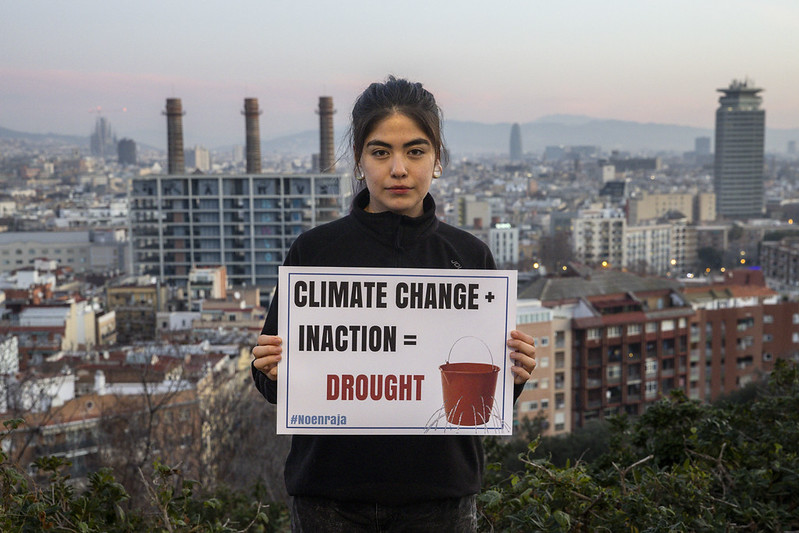Emergency declaration due to drought in Catalonia: Environmental, social and neighborhood groups regret the lack of responsibility and courage of the Administrations and ask to reduce the demand for water with urgent structural measures.
Coinciding with the declaration of emergency due to drought in the Ter-Llobregat Systemneighborhood, social and environmental organizations, grouped under the campaign “Where there is none, it cannot be taken” went up to Montjuïc (Barcelona) today to show a panoramic view of the city, the second largest in Spain by population, and thus remind all citizens that they depend on water management. With a message that read “Climate change + Poor management = drought”, they recalled that six million people will be affected by this declaration of drought, and by more cuts in the future.
Poor management by the Government and excess partisanship in the Parliament of Catalonia
The organizations highlight the poor management by the Generalitat in the application of the Special Plan for Sequera (PES). The consumption data of economic activities with a water concession granted by the Catalan Water Agency (ACA) are not public, therefore, they point out that they do not There is a way to know if the PES is being met and if the restrictions are sufficient.
They also point out the attitude interested and partisan which has led to the modification of the PES on several occasions, in order to relax measures. Specifically, they point to PSC and Junts that, with their amendments to Law 9/2023 of extraordinary and urgent measures to address the exceptional drought in Catalonia, They allowed the filling of hotel pools and the delay of sanctions after the summer, a critical moment due to water consumption caused by irrigation and tourism, relaxing the pressure on the City Councils.


Poor management by the Catalan municipal level
The Town Councils have powers over the supply of drinking water and sewerage at the municipal level. Therefore, they have responsibility for everything that happens in the network, such as repairing leaks and controlling urban water consumption. The organizations report that, in general, municipalities have shied away from their water duties. Likewise, they remember that only 7% of the municipalities of Cataloniawith more than 20,000 inhabitants, are required to have a Municipal Drought Plan and, of these, only 1 in 4 have it activated.
Catalonia is one of the areas in the world with the greatest private water management: 78% of the population is supplied by private operators. “All contracts with private operators contain investments to improve the performance of the networks that are charged to the water rate. Now, With public money, we pay for the poor management of the City Councils, who have not inspected the private operators who for decades have pocketed millions of euros at the expense of an essential service «they point out from the campaign.
Poor management in the hydraulic planning of the Generalitat of Catalonia
According to the Water Exploitation Index (WEI), Catalonia overexploits its available fresh water by 31%. This means that current demand exceeds the sustainable use of water resources, which leads us to depend on unconventional resources such as desalination and regeneration. “These technologies should function as reserves in times of need, but in no case can they be structural resourcessince they are intensive in the use of electricity and, therefore, increase the price of water and contribute to climate change”, they warn.
The Management Plan for the River Basin District of Catalonia (PGDCFC 2022-2027) foresees a moderate growth in water demand for the period 2027-2039 (between 1.8% and 6.3%), while the scientific community predicts a 17.8% decrease in water availability by 2051.
Faced with this scenario of increasing deficit, organizations warn that It is not sustainable to continue promoting this model based on construction and tourism. In 2023, Catalonia will welcome 16.9 million tourists, 21% more than the previous year, according to the National Institute of Statistics (INA). For 2039, a 25% increase in tourism is planned and different Urban Master Plans are in the approval period, such as the Metropolitan PDU and the HardRock project.
Poor management of the agricultural and livestock model of the Generalitat of Catalonia
Aquifers are the second source of water resources in Catalonia and they are strategic in times of drought. Hence, planning promotes the recovery of local wells to take advantage of them in times of scarcity like the current one.
However, the entities warn that The intensive and industrialized agricultural and livestock model is the main cause of the contamination of 57% of groundwater, leaving these sources unusable in times of drought. The contamination of available water, they point out, is a serious problem due to an unsustainable agricultural and livestock model, that it is necessary to reformulate with criteria of social justice.
Commits to the management and reduction of water demand in Catalonia
In June 2023, the groups handed over to the president of the Government of Cataloniathe advisor of Climate Action and the director of the Catalan Water Agency a document with 43 concrete proposals to address the drought and protect water as a public good, common good and human right.
The organizations promoting the campaignYou can not get something out of nothing” They ask to change the current paradigm of water management, based on supplying water to all sectors that demand it, as if it were infinite, and decisively betting on a progressive reduction, starting with the sectors that consume the most..

